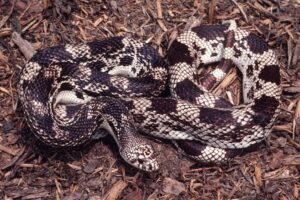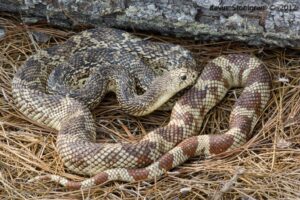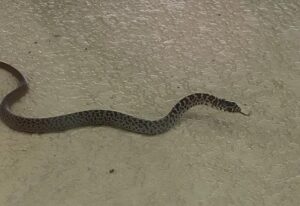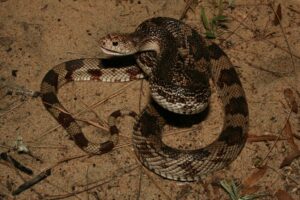The pine snake is a powerfully built, large colubrid native to the southeastern United States. Its specific name, melanoleucus, is derived from “melano” meaning black, and “leucos” meaning white. It refers to its black and white body. Other common names of the species are common pine snake, black and white snake, chicken snake, carpet snake, horn(ed) snake, North American pine snake, New Jersey pine snake, and eastern pine snake.
Scientific Classifications
- Suborder:Serpentes
- Family:Colubridae
- Genus:Pituophis
- Species:P. melanoleucus
Conservation Status
Subspecies
This snake has three recognized subspecies.
- Northern pine snake (Pituophis melanoleucus melanoleucus)
- Black pine snake (Pituophis melanoleucus lodingi)
- Florida pine snake (Pituophis melanoleucus mugitus)
Description
Size
The adults get as big as 48-90 in (120-230 cm) in total length, including the tail.
Color and Appearance
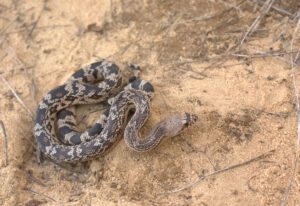
The pine snake has a light ground color overlaid with brown, black, or reddish-brown blotches. The small head is somewhat pointed, having an enlarged rostral scale that extends upwards, occupying the space between the internasal scales. Usually, 4 prefrontal scales can be seen. The midbody bears 27-37 rows of keeled dorsal scales. There is a single anal plate. The belly is white with dark spots at the sides.
Are They Dangerous to Humans
The pine snake avoids contact with humans. When disturbed, the colubrid often hisses loudly, sometimes vibrating its tail, flattening its head, and eventually striking. It produces the hissing sound by forcing air out of its lungs, thereby vibrating its epiglottis. Though non-venomous, its bite can be very painful and bloody.
Pine Snakes at a Glance
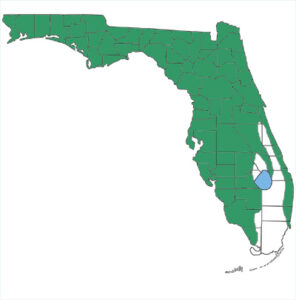
Distribution
It occurs in Florida, Alabama, Georgia, Louisiana, Kentucky, Mississippi, North Carolina, New Jersey, South Carolina, Delaware, Tennessee, and Virginia.
Habitat
The pine snake lives in sandy pine-oak woodlands, pine flatwoods, prairies, open brushlands, cultivated fields, chaparrals, and rocky deserts. It can be found from sea level to an altitude of 9000 ft (2700 m).
It remains underground during the hot summer days and cold weather. Its nesting and hibernating sites are well-drained, sandy soils with scarce vegetation. The communities in New Jersey hibernate in groups, while those in other regions like Tennessee hibernate singly. Habitat loss is a major threat to the species that can be checked by building hibernacula.
Lifespan
The serpent lives for 15-20 years.
Predators
The pine snake’s predators are striped skunks, American red foxes, and northern short-tailed shrews.
Diet
It preys on mice, rats, moles, other small mammals, and their eggs. The excellent burrower often enters rodent burrows for foraging. There, it can kill multiple mice by pressing the prey against the walls.
Reproduction
Oviparous (lays eggs that hatch outside the body)
After mating in spring, clutches of 3-24 eggs are laid from June to August. The eggs, deposited under logs or large rocks or in sandy burrows, hatch after 64-79 days. The eggs are sticky and quite large, up to 2.6 in (66 mm) long and 1.8 in (45 mm) wide. The hatchlings measure 13-18 in (33-45 cm).
Care Sheet
Size of the Enclosure: As they require a lot of space, an adult can be housed in a 55-75 gallon glass tank with a secure screen cover.
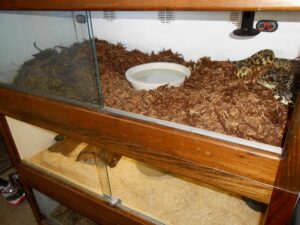
Temperature: The hot side of the cage should be kept at 90°F and the cool side at 75-85°F. The temperature should not fall below 65°F at night.
Humidity: They need an average humidity level of 60-70%. A securely placed, heavy reptile water dish filled with clean water should be included in the tank, as the snake drinks a lot of water.
Substrate: A few inches deep layer of ground pine bark mulch helps the pet to burrow freely. Another suitable option is dust-free beach sand.
Feeding: The fast-growing, strong snake needs a steady diet of rodents or poultry like rats, mice, chicks, quail, and eggs. An adult should be fed a couple of appropriately sized (slightly smaller than the pet’s widest point) prey items in a single sitting, twice a week. The juveniles can be fed every 3-4 days.
Source
herpsofnc.org, cbs19news.com, reddit.com, ufwildlife.ifas.ufl.edu, flickr.com, slitherbriggs.webs.com, herpsofnc.org

